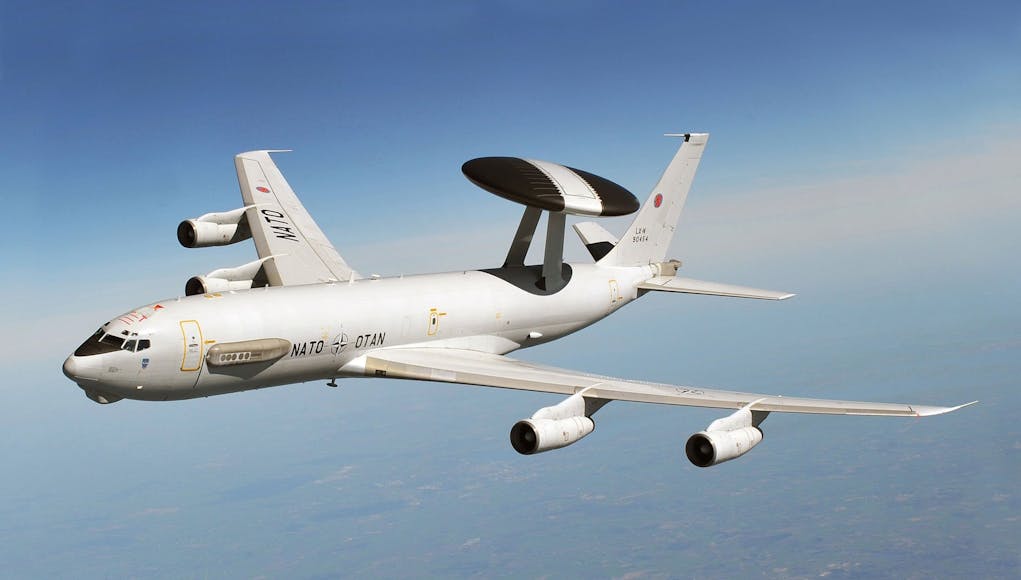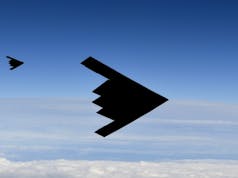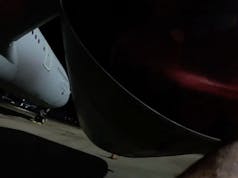From orbits over Turkey and international waters of the Eastern Mediterranean, NATO AWACS can look into Syrian airspace using its on board radar and sensor suite.
This surveillance, say NATO, has improved safety and has provided better situational awareness to coalition commanders.
NATO AWACS are able to coordinate Coalition aircraft during their missions in the fight against DAESH. In this capacity they act in a similar fashion to an airborne Air Traffic Control capability. This allows them to coordinate aircraft movements and ensure safe airspace use by coalition aircraft.The alliance press office however is keen to note that NATO AWACS are not involved in the direction of fighters or bombers onto targets.
“Our job is to make the airspace for the coalition assets much safer. This rare capability is a key contribution and makes a huge difference to all allied aircraft involved,” said Colonel Bas Pellemans, Deputy E3-A Component Commander, Royal Netherlands Air Force.
According to a press release:
“NATO AWACS have officially recorded over 1000 mission hours, since October 2016, in respect of the Global Coalition to Counter ISIL.
The expanded AWACS mission contributes to the Counter ISIL effort and is a clear signal of NATO’s determination to help fight terrorism. By providing AWACS support, NATO is demonstrating its resolve to tackle security challenges coming from the south.
NATO AWACS are operating out of Konya, Turkey. They have flown more than 140 mission sorties and more than 1000 hours in support of the fight again DAESH. 17 Nations are currently contributing to NATO’s eyes in the sky.”













[…] post NATO AWACS record over 1000 mission hours in fight against Islamic State appeared first on UK Defence […]
Fantastic aircraft, used to see them all the time at Geilenkirchen but they are getting long in the tooth, I wonder what will replace them?
Drones in the case of the Americans they’ve decided they’re to vulnerable, for us nothing I’d imagine
Why?
AWACS / ASCS is a critical part of our ISTAR assets. Something will replace them.
Updated in the short term I imagine.
AWACS have needed updating for years even just to bring them up to USA /French standards and will cost billions by some accounts, it just will not happen. Something on a new airframe is needed but where does the money come from? More p8s with overland capability would be a better bet but money money money
Our E3Ds have had their computers and software updated but the radar is still essentially an “analogue” AN/APY-2 dating from the 80’s. This is an S band (E-F) band radar that scans a sector every 10 seconds. So by today’s standards is quite old fashioned. It is however very powerful and can still detect low RCS targets due to glinting and resonance. In some respects the upgraded Searchwater that will be used in the Crowsnest program is a much more advanced radar. As it uses a mechanically rotating active scanned array group of radar modules so is multi-functional. This gives the advantage of very narrow beam forming, but also low probability of intercept and multi beam searching to name but a few.
The E3D uses a Boeing 707 airframe which are no longer in production, with a lot of new operators using 737 or 767 airframes.
I believe Saab have shown one possiblet route for the UK with their GlobalEye system, which uses a Bombadier Global 6000 for the airframe. The GlobalEye is networked with a ground station using Link 16, therefor less operators are needed on the aircraft.
SAAB Erieye has been offered to the RAF on the back of a number of ‘spare’ Voyagers. RAF showed some interest but it came to nothing. 2015 SDSR was supposed to have earmarked money to upgrade our E3Ds but nothing’s been done so far. Existing fleet becoming more and more difficult to operate and maintain. Could go the way of Turkey and Oz and buy Wedgetail on a 737 airframe. Don’t think for a moment however, that the RAF will abandon AEW/ASAC. Situation will become more critical with the introduction of F-35 because without an associated C2 node to help make sense of the enormous amount of information gathered and the associated coordination and control functions and reach back to joint headquarters in U.K., F-35 will be a wasted asset. There’s also been talk of turning Voyager into a C2 node for F-35, by the way, but I don’t know if that proposal is going anywhere…
I feel starved of news, this has become the first site i visit, after a quick check on the bbc for armagedon
Anyway, this mission can be done by a drone hoisting an “Aegis Airbourne”, its become a decidely risky mission now.
Andy, I think that an aerial Aegis on a RPAS is still some years away. Power and cooling main problems. I’ve often thought along similar lines in that we have in SAMPSON one of the best air warning radars in the world. Surely it could be repackaged into an airborne platform of Voyager size or even A320/B737? Probably, but it would be expensive, risky and time consuming. Why do that when you can buy Wedgetail off the shelf? I think a combination of a number of RPASs with a manned platform will eventually appear, but I suspect not for a number of years.
I believe the power requirements of the enhanced Searchwater 2000 that will be used for the Crowsnest program is just about attainable in a UAV. The drone however would have to be quite a size as it would need at least 40 to 100 KVA to power the radar, control system and datalink. There are a number of airframes that come to mind that could operate from our QE carriers. One would be the Bell V247 tiltrotor, the other would be Leonardo’s Project Zero but modified so its powered by gas turbines. For a fixed wing UAV operating from land you would be looking at something the size of the Northrop Grumman RQ4 Global Hawk or the Piaggio Hammerhead.
The enhance Searchwater with the AESA antenna array will be a awesome airborne search radar, it won’t have a massive range compared to the E3D or E2Ds.
Yes you are right, I didnt mean this is available right now.
You could also ditch radar entirely and use satelite lidar. Assuming of course the planes aremt invisible.
Has UKDJ become stuck in some kind of timelock?
It is the weekend. And nothing new on Friday makes it seem ages since new articles posted.
Definitely not ‘current’ at the moment….
Is UKDJ on holiday?
What is going on with this site? Nothing for days now.
Impartial, current….. & on holiday lol.